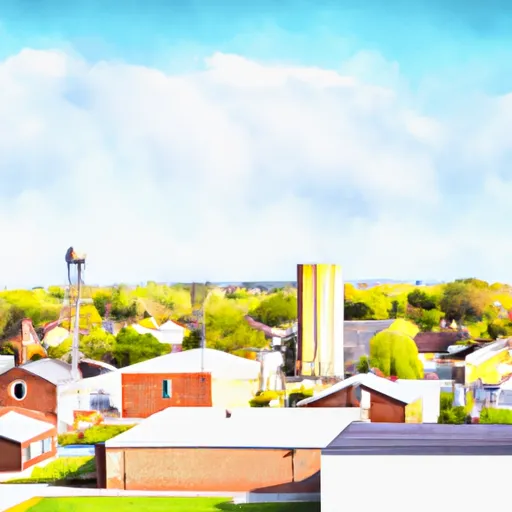-
 Snoflo Premium
Snoflo Premium
Get unlimited access to all our content
With no Ad interruptions! - Start Your Free Trial Login with existing account
Yorkville
Eden Index
Climate
7.7
•
Recreation
3.5
•
Community
3.6
•
Safeguard
5.2/10

Yorkville, Illinois, located approximately 50 miles southwest of Chicago, boasts a diverse climate characterized by warm summers and cold winters. The area experiences an average annual temperature of around 50°F, with July being the warmest month and January the coldest. Precipitation is fairly evenly distributed throughout the year, with an average of 38 inches of rainfall and 31 inches of snowfall annually.
Hydrologically, Yorkville is situated near the Fox River, a prominent waterway that offers various recreational opportunities. The river supports fishing, boating, and kayaking, allowing residents and visitors to enjoy the picturesque surroundings and diverse wildlife. Additionally, the Fox River Trail provides a scenic route for hiking, biking, and running, stretching over 40 miles.
Yorkville also embraces outdoor recreation through its numerous parks and green spaces. Silver Springs State Fish and Wildlife Area, located just east of the city, offers opportunities for hunting, fishing, and wildlife observation. The nearby Raging Waves Waterpark provides a thrilling water adventure, featuring water slides, wave pools, and lazy rivers.
Overall, Yorkville, Illinois, provides a favorable climate, abundant water resources, and a variety of outdoor recreational activities, making it an attractive destination for nature enthusiasts.
What is the Eden Index?
The Snoflo Eden Index serves as a comprehensive rating system for regions, evaluating their desirability through a holistic assessment of climate health, outdoor recreation opportunities, and natural disaster risk, acknowledging the profound impact of these factors on livability and well-being.
Climate Health Indicator (CHI): 7.7
Yorkville receives approximately
938mm of rain per year,
with humidity levels near 82%
and air temperatures averaging around
10°C.
Yorkville has a plant hardyness factor of
5, meaning
plants and agriculture in this region thrive during a short period during spring and early summer. Most
plants will die off during the colder winter months.
By considering the ideal temperature range, reliable water supplies, clean air, and stable seasonal rain or snowpacks, the Climate Health Indicator (CHI) underscores the significance of a healthy climate as the foundation for quality living.
A healthy climate is paramount for ensuring a high quality of life and livability in a region, fostering both physical well-being and environmental harmony. This can be characterized by ideal temperatures, reliable access to water supplies, clean air, and consistent seasonal rain or snowpacks.
Weather Forecast
Streamflow Conditions
Upper Illinois
Area Rivers
Upper Illinois
Snowpack Depths
Upper Illinois
Reservoir Storage Capacity
Upper Illinois
Groundwater Levels
Recreational Opportunity Index (ROI): 3.5
The Recreational Opportunity Index (ROI) recognizes the value of outdoor recreational options, such as parks, hiking trails, camping sites, and fishing spots, while acknowledging that climate plays a pivotal role in ensuring the comfort and consistency of these experiences.
Access to outdoor recreational opportunities, encompassing activities such as parks, hiking, camping, and fishing, is crucial for overall well-being, and the climate plays a pivotal role in enabling and enhancing these experiences, ensuring that individuals can engage in nature-based activities comfortably and consistently.
Camping Areas
| Campground | Campsites | Reservations | Toilets | Showers | Elevation |
|---|---|---|---|---|---|
| Gratiot River County Park | None | 626 ft | |||
| McLain State Park | 100 | 625 ft | |||
| North Canal Township Park | 19 | 633 ft | |||
| Jurgens City Park | None | 658 ft | |||
| Sam Dale Lake Conservation Area | None | 493 ft | |||
| Gibson City Park | 4 | 731 ft | |||
| South City (Gibson) Park | None | 741 ft | |||
| Natchez Trace State Park | 50 | 637 ft | |||
| Village Park | 26 | 603 ft | |||
| Charley Brown City Park | None | 487 ft |
Nearby Ski Areas
Catastrophe Safeguard Index (CSI):
The Catastrophe Safeguard Index (CSI) recognizes that natural disaster risk, encompassing floods, fires, hurricanes, and tornadoes, can drastically affect safety and the overall appeal of an area.
The level of natural disaster risk in a region significantly affects safety and the overall livability, with climate change amplifying these risks by potentially increasing the frequency and intensity of events like floods, fires, hurricanes, and tornadoes, thereby posing substantial challenges to community resilience and well-being.
Community Resilience Indicator (CRI): 3.6
The Community Resilience Indicator (CRI) recognizes that education, healthcare, and socioeconomics are crucial to the well-being of a region. The CRI acknowledges the profound impact of these elements on residents' overall quality of life. By evaluating educational resources, healthcare accessibility, and economic inclusivity, the index captures the essential aspects that contribute to a thriving community, fostering resident satisfaction, equity, and social cohesion.

